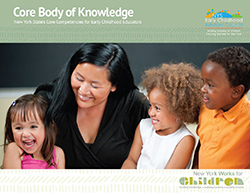
Core Body of Knowledge
New York State's Core Competencies for Early Childhood Educators

1.4
Resources for Competency 1.4:
2
click to view resource list
Gross, Fine, Graphomotor Development
The professional working with young children supports children's gross, fine, and graphomotor development
Resources & Media for Understanding Competency 1.4
Behaviors & Skills
-
aProvides the appropriate environments, toys materials, equipment and instructions to encourage a variety and range of motor skills
-
bHelps children master self-help skills like eating, toileting, and dressing
-
cCreates opportunities for children to practice skills that develop coordination, balance, movement, and strength:
- Locomotor skills: rolling, crawling, walking, running, jumping, hopping, galloping, sliding, skipping, leaping
- Object control: throwing, catching, kicking, striking, trapping, dribbling, ball rolling
- Stability Skills: turning, twisting, bending, stretching, reaching, lifting, balancing
- Activities that cross the midline: (i.e., easel painting, clapping pattern games)
-
dLeads physical activities at a moderate to vigorous level
-
eProvides opportunities/activities that strengthen hand and finger muscles, as well as coordination
-
fMakes sure that indoor and outdoor environments allow children to move freely
-
gEnsures that children spend time each day in outdoor gross motor play
-
hSupports children in their pursuit of reasonable physical challenges
-
iProvides children with opportunities and materials that foster sensory integration
-
jAdapts physical activities to the skill and developmental level of the children, as well as to the environment (i.e., backyard, gym, classroom, living room)


